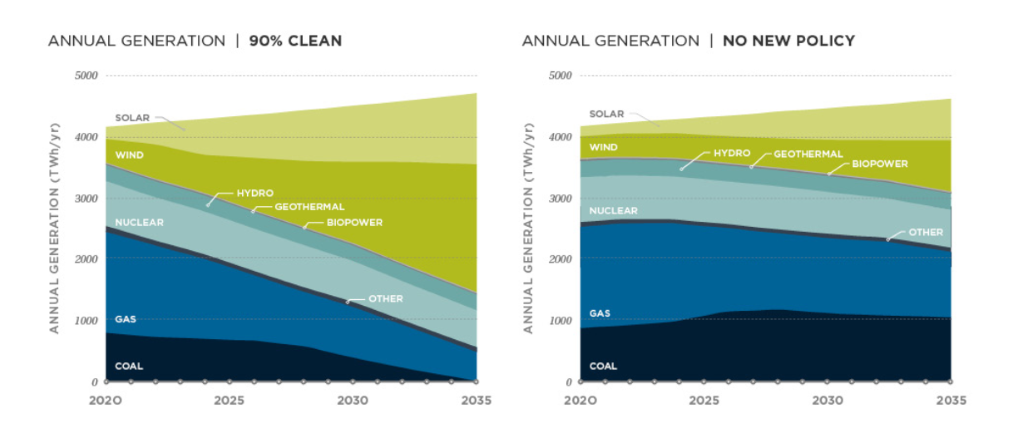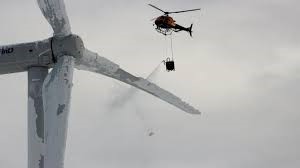New Energy Insights
- Home /
- New Energy Insights /
- The Future of the Grid: The Evolution of Energy in America
As we embrace a Federal Administration that is focused on grid modernization and the evolution of energy in America, we must start to imagine what the 21st century grid will look like. The majority of the grid infrastructure that stands today – the poles and wires known as transmission and distribution lines – was built in the late 1800s to the mid 1900s, finally reaching completion in 1967, and coast-to-coast interconnection was achieved. However, since its completion, the physical grid itself has changed very little, even as the evolution and proliferation of distributed energy resources like solar and wind have transformed the energy landscape as we know it. It’s past due time to modernize our grid.
First, let’s examine the future through a political lens. President Biden campaigned on a promise to achieve a 100% Clean Electricity by 2035, setting a national Clean Energy Standard (CES). However, as we know, campaign trail promises don’t always materialize. Is the President’s CES feasible? The answer to this question will determine what the future of the grid will be.
Biden’s word choice of “clean electricity” is distinct from “renewable electricity,” and this distinction matters. Clean electricity is technology-agnostic: all that it requires is zero-carbon or extremely-low-carbon inputs. In the Goldman School of Public Policy’s 2035 report1, which provides insight into what a 90% clean energy grid by 2035 would look like, “wind, solar, and batteries provide 70% of annual generation, while hydropower and nuclear provide 20%. During rare periods of very high demand and/or very low renewable generation, existing natural gas, hydropower, and nuclear plants combined with battery storage cost-effectively meet demand.” While the lion’s share of energy will be coming from renewables, “clean energy” still allows for flexible natural gas to participate in the mix, which can provide on-demand and quick-response energy. The best part? A clean, carbon-free nationwide grid can be met, dependably, at no extra cost to consumers, without new fossil fuel plants. In order to achieve this goal, this report describes the policy outcomes of merely a 90% clean energy grid – what about the final 10%? The report outlines that this will come by 2045 through investments in R&D.
The 2035 report.1
The takeaway here is that we can decarbonize our entire power sector – 90% – with existing technologies, mainly solar and wind. Let it be clear that this type of ambition is only possible due to the cost of solar and wind plummeting faster than even the most optimistic experts predicted. With the economics in line, all market forces are contributing towards the 100% clean energy future, including utilities themselves2, who historically have been fighting to stop renewables. Additionally, Secretary of Energy Jennifer Granholm is poised to make this vision a reality. The former governor of Michigan has been a strong clean energy and grid modernization advocate, and is expected to enable the clean energy transition.
In light of the severe power outages in Texas, one might question whether this energy transition will risk more catastrophes like the complete failure of the grid in Texas. Despite politically-motivated finger-pointing on both sides of the aisle, the truth of the blackouts is not political, it is a direct result of a lack of planning. . ERCOT – Texas’ independent grid operator – reported over 31GW of thermal outages (natural gas, coal, and nuclear), while wind energy reported roughly 4GW of outages3. In this case, all of us need to leave our energy tribal camps and understand the system-wide problem. The main story here is that gas lines haven’t truly been winterized the way they are in, for example, Minnesota and Alaska; and the same can be said for solar and wind. After all, this is Texas we are talking about, and the polar vortex event was a freak chance occurrence!
Winterization upgrades for natural gas plants entails retrofitting plants with a heating structure for the winter which can be removed in the summer. For wind plants, winterization entails adding special coatings and heating elements. These retrofits can cost 10% of the total project cost, and are financially equivalent to buying project insurance4. After the outages in Texas, these retrofit costs will be easily accepted.
Wind outages: 4-5 GW outage out of 6GW total; mainly due to frozen turbine.
The disaster in Texas also goes to show the importance of grid reliability. ERCOT, if it learns nothing else, will learn to winterize its natural gas facilities. California, soon entering the next wildfire season, will have to adapt and insure against fire risk. In essence, our 21st century grid needs to become more resilient to unknown risks. One way grids can adapt is through the adoption of energy storage. Utilities can install large batteries -which are cheap and effective- rather than upgrading their aging infrastructure. This is known in the industry as Non-Wires Alternatives (NWA). Instead of utilities paying for expensive substation, feeder equipment, or distribution lines to accommodate renewables, they have the option to install a large battery that can absorb or inject reactive energy on demand.5 In parallel, as we see consumers increasingly opt for electric vehicles that need to be plugged in to charge, we will begin to see a large number of car batteries charging at the same time. If appropriately managed, widespread EVs can provide arbitrage opportunities to help balance the grid’s needs, potentially even making the car-owner a couple bucks in the process.
In order to meet the established goal of 100% clean and reliable energy by 2035, we also need to focus our attention on the physical infrastructure itself: high voltage transmission lines. With the rise of ubiquitous, resilient, and clean energy sources, we need to deal with the intermittency problem. Even in the sunniest and windiest states, you cannot always guarantee a steady supply of renewable energy. However, if we plan on linking together vast geographies through long distance transmission lines, suddenly you can smooth out the peaks and valleys. In other words, Texas may not have been able to get any of its power plants (fossil fuel or renewable) to turn on, but perhaps it could import heat or electrons from Washington State, Illinois, or Maryland.
A last item to consider are smart meters. Most of our grid was built over a century ago, and has not been upgraded since the ‘80s. Utilities and grid operators have since seen an explosion in complexity from customer demand, environmental goals, and the rise of distributed energy. And yet, there is a significant lack of data sophistication to manage all the variables on the modern grid. Smart meters offer a wealth of value to both customers and utilities. These devices provide both parties with highly accurate data on energy usage, both in real time and on historical time scales, via a simple website or mobile app. Because customers can easily monitor their usage, they can also adjust their energy use, in turn, saving money.
Importantly, the widespread adoption of smart meters would allow utilities to better understand energy trends and implement Time of Use rates: when a customer sees different energy prices at, say, 1pm vs 6pm. Most of the changes mentioned in this article have been supply-side changes to the energy landscape. However, a Time of Use tariff structure incentivizes customers to adopt easier energy consumption practices; a technique known as Demand Response. On the grid, energy supply and demand must always be met equally, so that whenever a customer flips a switch, there is light. Historically, utilities and grid operators are the ones who calculate and model exactly how much energy will be needed on any given day. Demand Response puts some of this work onto customers: it encourages energy efficiency, the usage of clean energy and batteries, and reduces the peak demand problem that plagues energy providers everywhere. Though Time of Use rates are not suited for all customers in the US now, we can expect these tariff structures to become more common in the years to come.
Given that we are witnessing more uncertainty and volatility caused by natural events, the US would be wise upgrade its grid to hedge against this. Every American should have access to resilient, consistent, and affordable energy 24/7.
REFERENCES:
-
- https://www.2035report.com/
- https://www.utilitydive.com/news/americas-investor-owned-utilities-we-can-achieve-a-100-clean-energy-futu/593723/
- https://twitter.com/JesseJenkins/status/1361691683222654980 - Jesse Jenkins is an energy systems engineer and professor at Princeton 4
- https://www.texastribune.org/2021/02/20/texas-power-grid-winterize/
- https://www.tdworld.com/overhead-distribution/article/20972703/nonwires-alternatives-nontraditional-solutions-to-grid-needs
How Can New Energy Equity Help You Reach Your Solar Goals?
Stay up-to-date with New Energy Equity by joining our mailing list.

-1.png)


